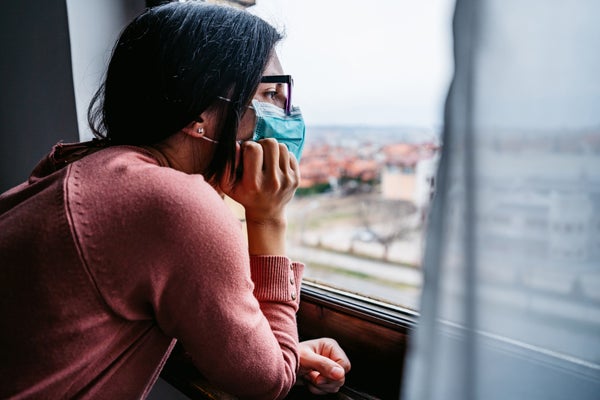If you’re thinking about the COVID pandemic as an assault against physical health alone, you’ve got it all wrong. The statistics on illness and death are staggering—but there’s been an equally staggering toll exacted on our mental health. Nearly one third of Americans are experiencing symptoms of clinical depression or anxiety, and the Well Being Trust estimates we will suffer up to 150,000 additional deaths tied to the social isolation and economic stressors associated with COVID-19.
In nonpandemic times, making choices that benefit both physical health and mental health was relatively straightforward, for these choices were often one and the same. Doing good for your body has tangible benefits for your mood and psychological well-being. For example, exercise significantly reduces anxiety and depression—at rates comparable to pharmacotherapy. Likewise, healthy sleep habits that foster physical homeostasis and more efficient immune system functioning also significantly reduce our risk for depression, anxiety and bipolar illness.
Yet the pandemic has uprooted our normal guideposts for navigating decisions about our health. Today, choosing to make healthy choices for minimizing risk of virus infection comes at a cost to our mental health, in both the short and the long term.
On supporting science journalism
If you're enjoying this article, consider supporting our award-winning journalism by subscribing. By purchasing a subscription you are helping to ensure the future of impactful stories about the discoveries and ideas shaping our world today.
For example, when we self-quarantine, we protect our physical health, but we also increase our social isolation, which augments our loneliness, foments negative emotions and limits access to crucial social support systems that buffer against depression. Parents who have protected their children from contracting or spreading COVID-19 by limiting playdates or homeschooling rightly worry about the unknown toll on their children’s socioemotional development of such absence of social interaction with peers. Young adults have missed monumental milestones including high school and college graduations—opportunities for collective processing and meaning making that have positive psychological and physical health benefits. Now these experiences represent a costly trade-off, leaving us wondering which side of our health we choose to protect.
This ever-present balancing act leaves us feeling that our physical and mental health are at odds, in a battle vying for attention: should you prioritize you and your family’s physical health, or your weakening mental health during this stressful and uncertain time? Yet, this calculus is even more complicated. Of course, we are not only concerned with our own physical or mental health, but with the well-being of the global human world as we balance our individual needs with that of our collective community.
Ultimately, even with three vaccines now approved for emergency use, we are still in this pandemic for the long haul. If we ignore our mental health needs, any issues we have may worsen, making it harder to recover when we finally try to address them and when the pandemic has etched into history. We offer a few evidence-based suggestions for how to approach this mental and physical decision duality:
We must adopt a community-centered solution to this problem, which recognizes and accepts that your approach to defining a cost-benefit ratio may differ from the approach of your neighbors and others with different personality or developmentally appropriate needs. For example, teenagers and young adults may need more contact with people outside their family to maintain their mental health. This is developmentally appropriate, so rather than criticize them for their behavior, we should think about creating guidelines for what healthy social distancing looks like across different developmental periods. Having one or two friends a teenager can consistently socialize with in person may be a sensible approach that balances physical and mental health concerns and may prevent risky social behavior.
It’s important to balance present versus future needs. Consider choices that will not only support you during the present moment but benefit your future self well after the pandemic is over. Although it can feel downright thrilling during COVID-19 times to get out of the house and finally meet up with friends at a park or shop online to buy that flashy new iPhone after being cooped up inside all day, doing so may lose a broader perspective of how it may affect your future self. Likewise, although it is natural for us to avoid upsetting feelings, when we do it frequently, excessively or in a way that prevents us from achieving our daily goals, it is referred to as behavioral avoidance. Behaviors such as not approaching friends when feeling depressed come at the expense of longer-term quality of life. Becoming saturated by fear in the moment or recurring melancholic thoughts might lead us to avoid needed medical attention, reach out connect with someone over the phone who could lift up our spirits, or make a trip to the grocery store to get needed food supplies when online Instacart delivery isn’t an option.
Remember that protecting your physical health doesn’t need to come at expense to mental health: There are many ways to support physical immunity and avoid risk of COVID-19 but still support your emotional needs. For example, you can stay socially connected to others even when geographically apart—whether it is through remote-based “meet ups” with old friends online, starting a gratitude journal or sending notes to those you care apart, and engaging in small acts of kindness to loved ones and strangers. All of these not only help you stay connected but also have been proven to buffer against potentially negative mental health outcomes and boost physical immunity to stressors.
During this global pandemic, we must embrace both the mind and body as central facets of our human health and survival. To survive the enduring pandemic ahead, we must recognize mental and physical health as mutually influential parts of human health that work best when they work together.
